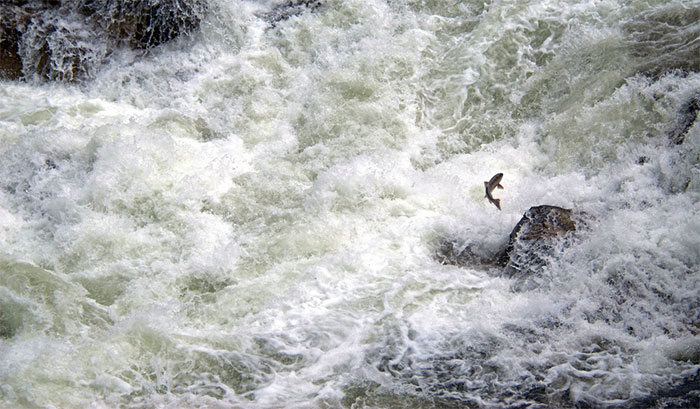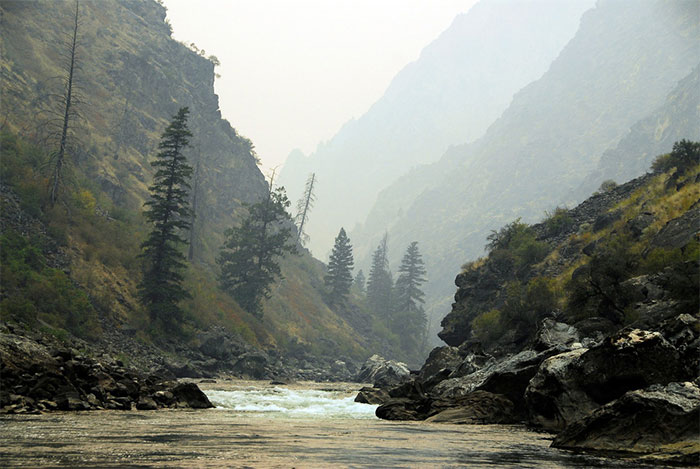Will hydroelectric dams eradicate the largest Pacific salmon?
The continuous flow of warm water, combined with the impact of hydroelectric dams, has led to a sharp decline in the size of the largest Pacific salmon species and the risk of wiping out.
Only 2% left

A Chinook salmon over Dagger waterfall, Idaho (USA) - (Photo: ALAMY).
Chinook (scientific name: Oncorhynchus tshawytscha ) is a typical salmon in North America, divided into many categories such as spring salmon, summer and autumn .
This fish usually lives in the waters from the San Francisco Bay to the north of the Bering Strait for 1-5 years before the upstream spawning in fresh water. After 12 - 18 months of age, salmon will flow downstream to the sea to grow and wait until the start of the next spawning cycle.
In recent years, the number of wild Chinook salmon has significantly decreased. For example, in the middle section of the Salmon River, if there were 45,000 to 50,000 salmon in the spring and summer in the spring and summer, that number is now only 1,500.

Impassable Gorge on the Salmon River stretch is a challenge that salmon must overcome on the way to the sea and back - (Image: ALAMY).
In addition, the Columbia River system also records the number of "free" salmon. Prior to the 20th century, scientists estimated that 10 to 16 million salmon travel around the river system annually, from the sea to the mainland and vice versa but now only about 2% of them, about 200,000 - 320,000 children.
Russ Thurow - an aquologist at the Rocky Mountain Research Station - said the Columbia River, known for its characteristic habitat of Chinook salmon, is now at risk of losing it permanently.
"It's hard to say, but it is possible that North American Chinook salmon will only exist in 4 generations, about 20 years," said Mr. Thurow.
Not only Chinook, 13 other species of salmon living in the Columbia River basin are also in danger, many of which are on the list of species that need urgent protection.
From the dams .

Lower Granite Dam - one of the dams has been criticized to block the movement of salmon - (Image: ALAMY).
Don Chapman - a retired American aquatic scientist - said that the main cause of "death" of the largest salmon in the Pacific was hydroelectric dams in the area.
Just over the 2,000km long Columbia River, there are more than 14 hydroelectric dams - accounting for about 44% of the total US hydroelectricity. Or the Snake River nearby is also carrying more than 15 dams. In which the river section where most of the salmon live in these 2 rivers has about 8 large dams.
Due to damaging hydroelectric dams, salmon often have to die on the journey to the sea to grow or return to the river to breed.
For example, on the Snake River, before there were 4 huge dams on the river where many Chinook salmon trout moved, out of the 100 adult salmon going to the sea, it was estimated that there were 3-6 returning to breed, however The current rate is only 1 child.
A number of salmon trawl initiatives have been developed, in addition to the idea of supporting fish through the dam by barge or truck, but still could not improve the situation, although these programs have cost nearly $ 16 million over decades.

Ladder for dam for salmon - (Image: GETTY IMAGES)
Another cause of impact on salmon is that the water in the river and the sea warms up while the fish likes cold water. Warm water also reduces the amount of plankton in rivers that feed on salmon. According to estimates, in 2015 warm temperatures killed 250,000 red trout.
Facing the current complicated situation, many organizations have been trying to mobilize the removal of dams that are blocking the movement of salmon to the sea but have not been successful. According to Don Chapman, as long as the current status of the river cannot be returned to about 30 years ago, the number of salmon, not just Chinook but many others, is still falling.
"We need to make a choice right before it's too late. Hydroelectricity enriches the country but has a negative impact on nature, a lasting resource," says Don Chapman. "No more hydroelectric dams will be created." energy, but lost salmon will be difficult to rebuild from scratch. "

A Chinook salmon is released into the ocean - (Image: Alan Berner)
Salmon is an important species in the food chain in many ecosystems, providing nutrition for about 137 species such as bears, eagles, and also species that are declining in numbers such as whales or killer whales. salmon is also a source of phosphorus, nitrogen . enriching plants, of which ¾ of the forest in Alaska and British Columbia developed thanks to salmon.
- Genetically engineered salmon in the US is controversial
- Canada used helicopters to rescue millions of salmon trapped by landslides
- Discover the world's largest hydroelectric dam
- The construction site of the second largest hydropower station in the world
- South Africa hydroelectric dam has a capacity of 480 billion liters of running water
- Hydroelectric dams can cause 70% extinction of wildlife
- Smashing the Mekong River
- The ancestors of salmon have sharp teeth 20cm long
- Hydroelectric dams: Loi is inadequate?
- Hydroelectric dams are discharging too much emissions?
- Chinese hydroelectric dams slow down the Earth
- Small dams threaten fish species on the Mekong River
- Detect 3 mysterious viruses that have not been detected in Pacific salmon species
- Russia implemented a salmon protection project for future generations
 Animal 'suffering' after hibernation
Animal 'suffering' after hibernation Why do goats climb well?
Why do goats climb well? Scientists were surprised to see chimpanzees eating turtles
Scientists were surprised to see chimpanzees eating turtles Giant catfish died deadly due to drought in Thailand
Giant catfish died deadly due to drought in Thailand